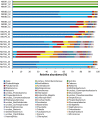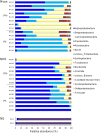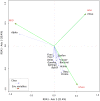Midgut microbiota of the malaria mosquito vector Anopheles gambiae and interactions with Plasmodium falciparum infection
- PMID: 22693451
- PMCID: PMC3364955
- DOI: 10.1371/journal.ppat.1002742
Midgut microbiota of the malaria mosquito vector Anopheles gambiae and interactions with Plasmodium falciparum infection
Abstract
The susceptibility of Anopheles mosquitoes to Plasmodium infections relies on complex interactions between the insect vector and the malaria parasite. A number of studies have shown that the mosquito innate immune responses play an important role in controlling the malaria infection and that the strength of parasite clearance is under genetic control, but little is known about the influence of environmental factors on the transmission success. We present here evidence that the composition of the vector gut microbiota is one of the major components that determine the outcome of mosquito infections. A. gambiae mosquitoes collected in natural breeding sites from Cameroon were experimentally challenged with a wild P. falciparum isolate, and their gut bacterial content was submitted for pyrosequencing analysis. The meta-taxogenomic approach revealed a broader richness of the midgut bacterial flora than previously described. Unexpectedly, the majority of bacterial species were found in only a small proportion of mosquitoes, and only 20 genera were shared by 80% of individuals. We show that observed differences in gut bacterial flora of adult mosquitoes is a result of breeding in distinct sites, suggesting that the native aquatic source where larvae were grown determines the composition of the midgut microbiota. Importantly, the abundance of Enterobacteriaceae in the mosquito midgut correlates significantly with the Plasmodium infection status. This striking relationship highlights the role of natural gut environment in parasite transmission. Deciphering microbe-pathogen interactions offers new perspectives to control disease transmission.
Conflict of interest statement
The authors have declared that no competing interests exist.
Figures




References
-
- Elango G, Rahuman AA, Kamaraj C, Bagavan A, Zahir AA. Screening for feeding deterrent activity of herbal extracts against the larvae of malaria vector Anopheles subpictus Grassi. Parasitol Res. 2011;109:715–726. - PubMed
-
- Farenhorst M, Hilhorst A, Thomas MB, Knols BG. Development of fungal applications on netting substrates for malaria vector control. J Med Entomol. 2011;48:305–313. - PubMed
Publication types
MeSH terms
LinkOut - more resources
Full Text Sources
Other Literature Sources

